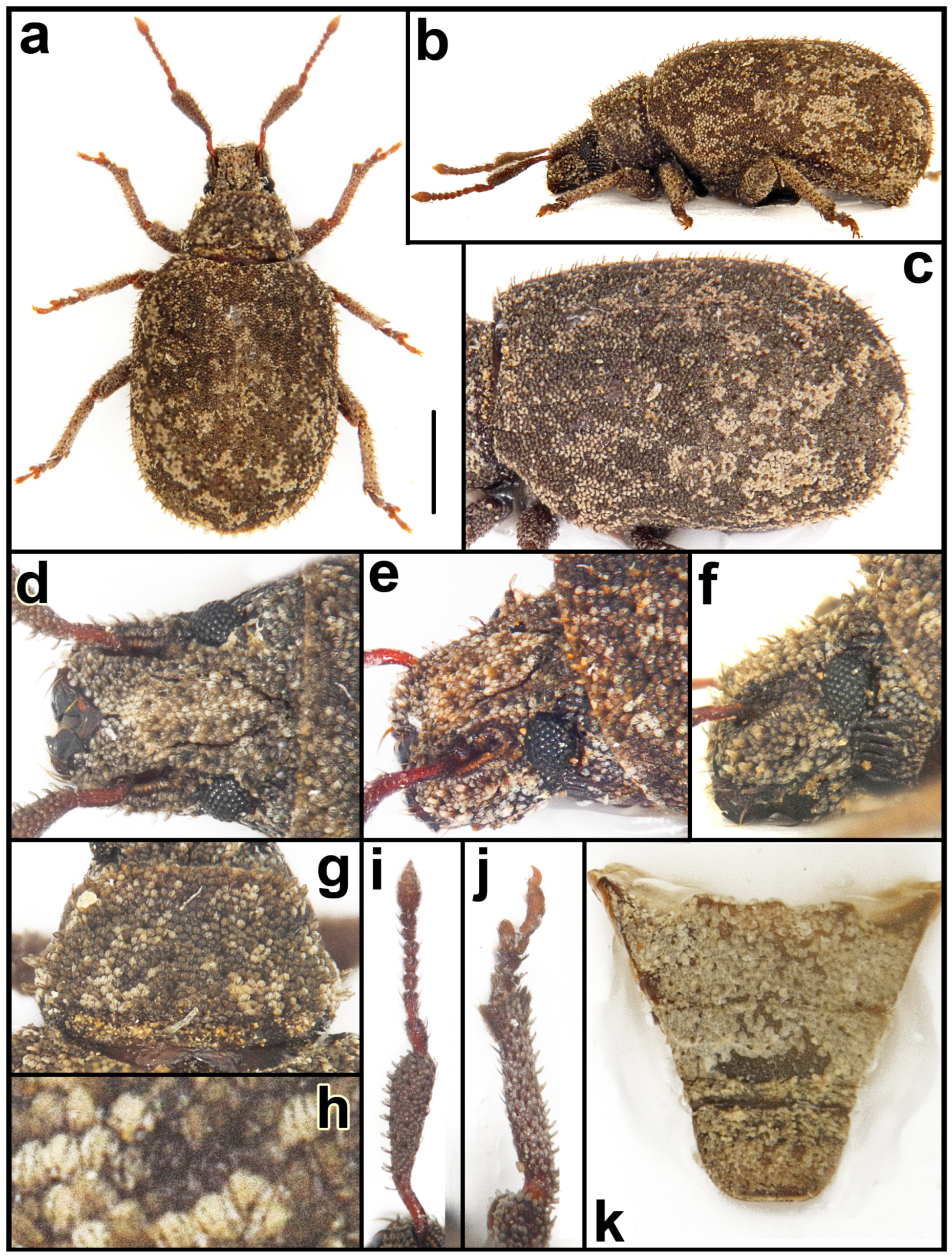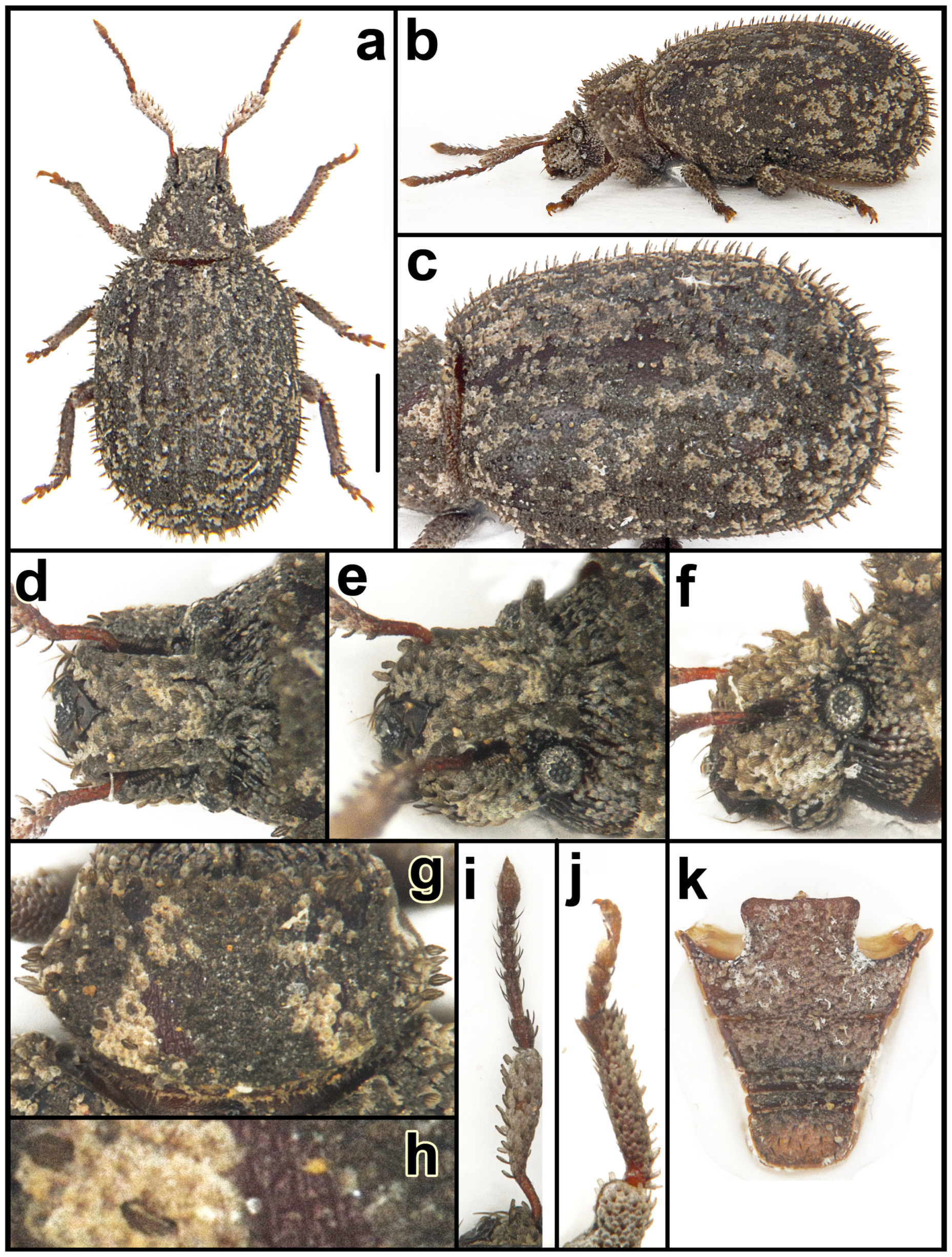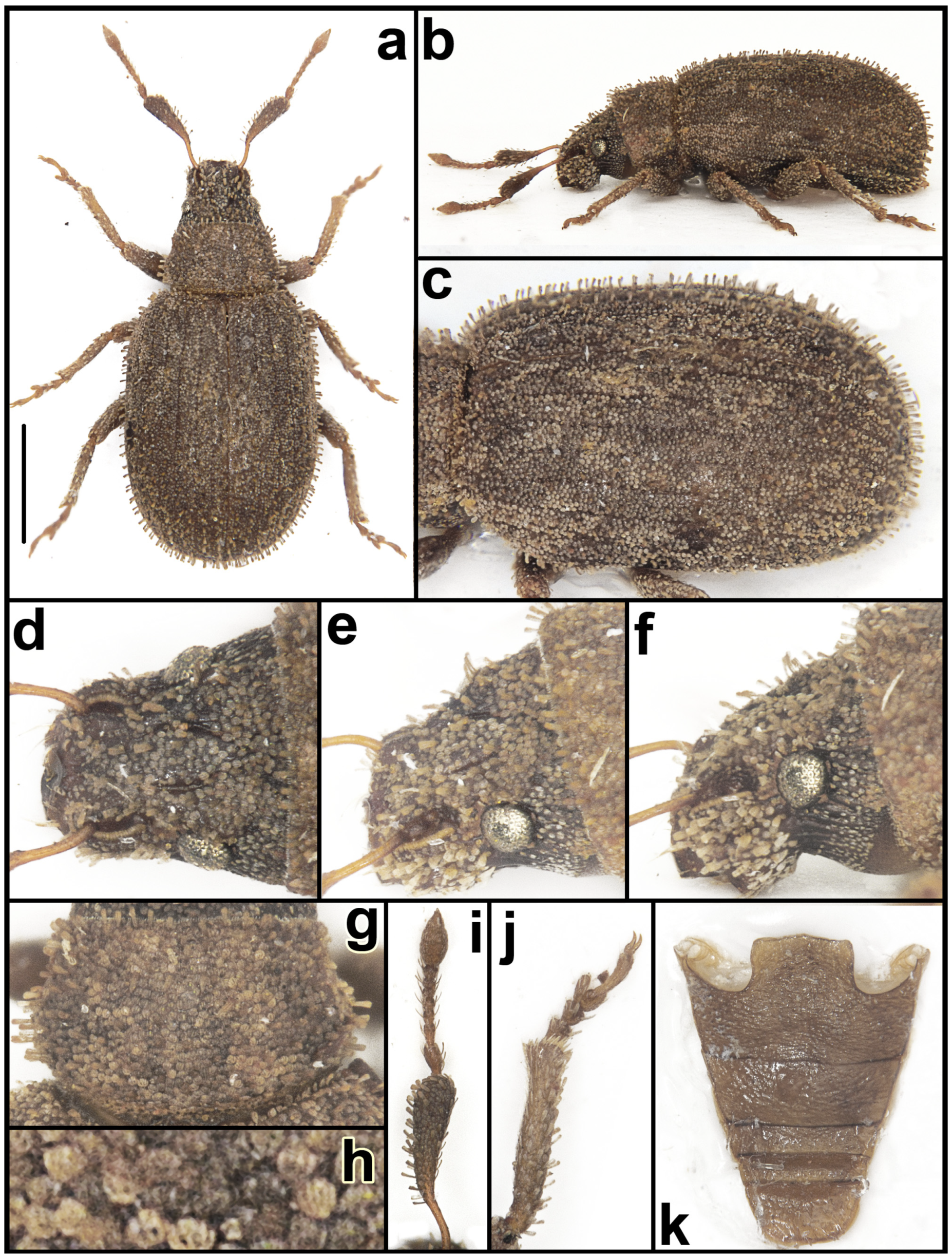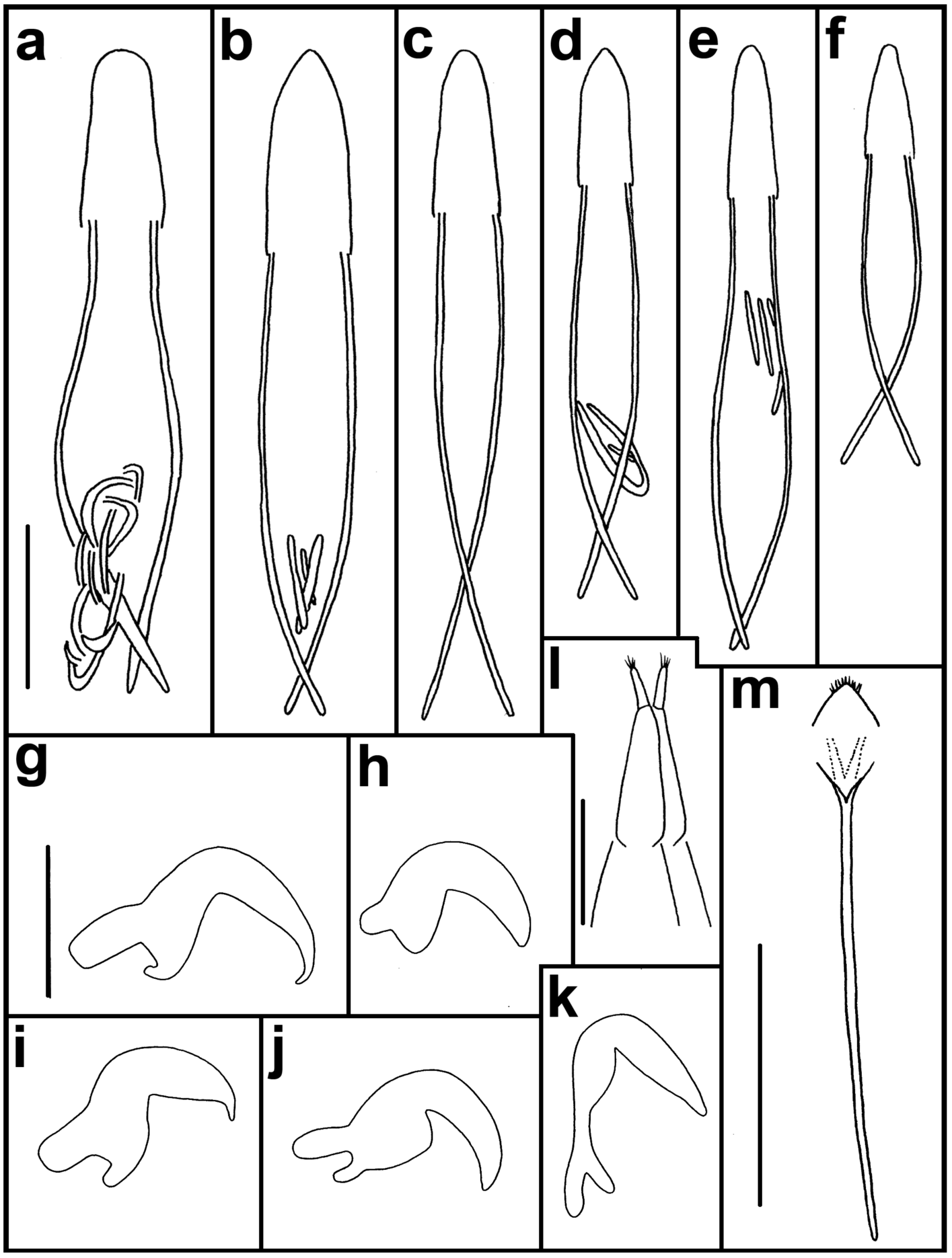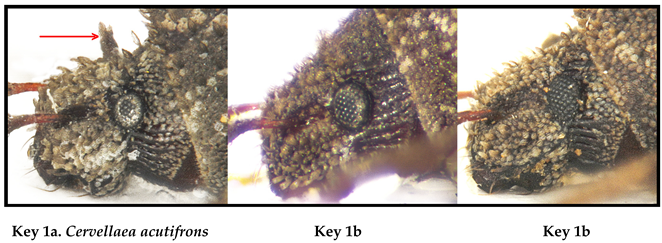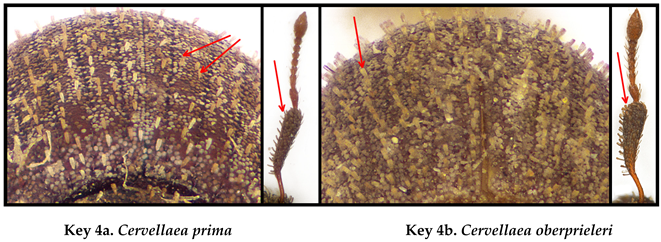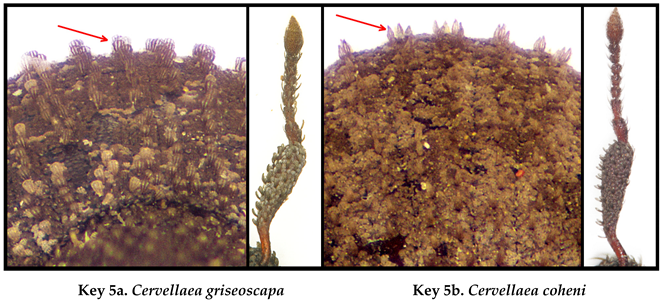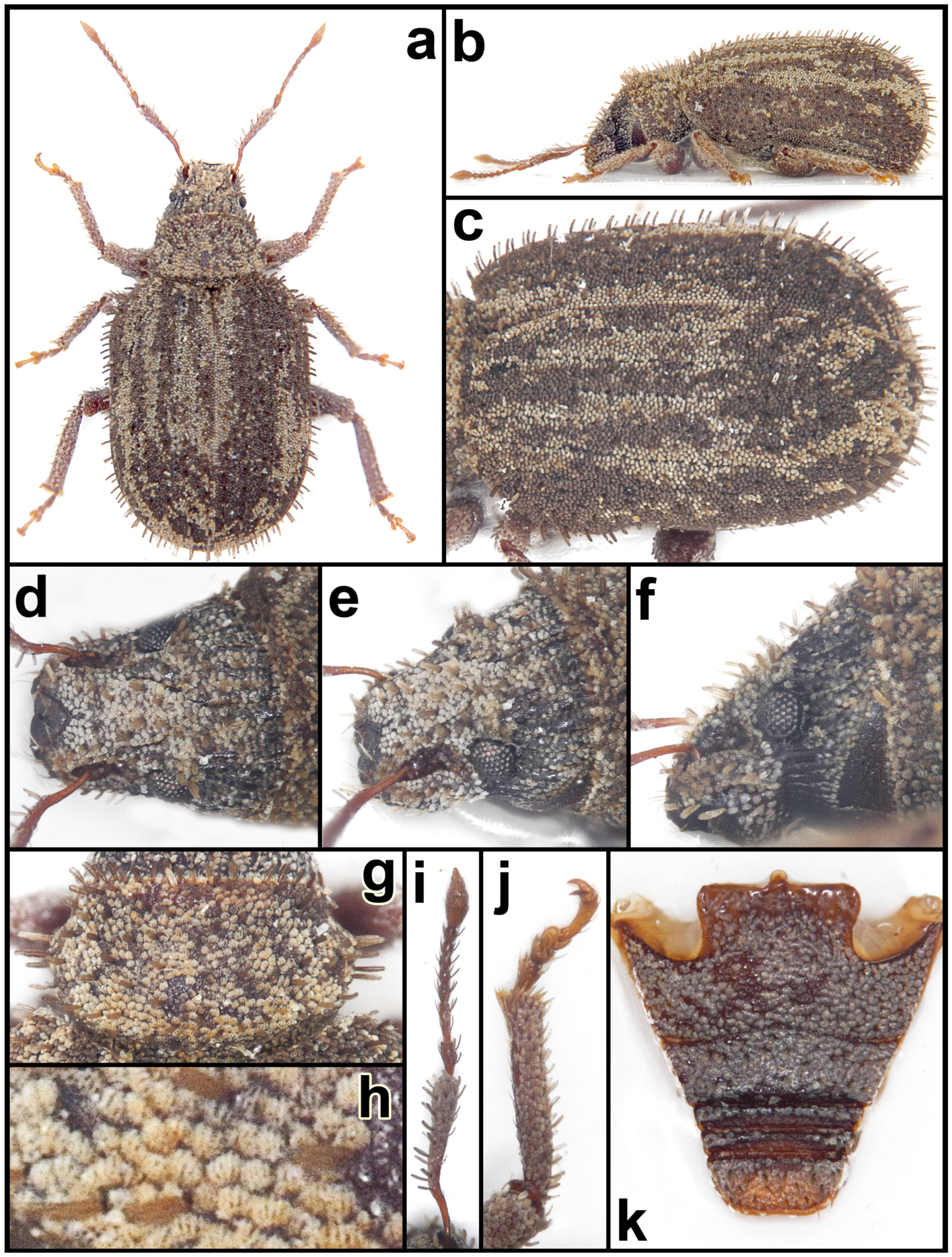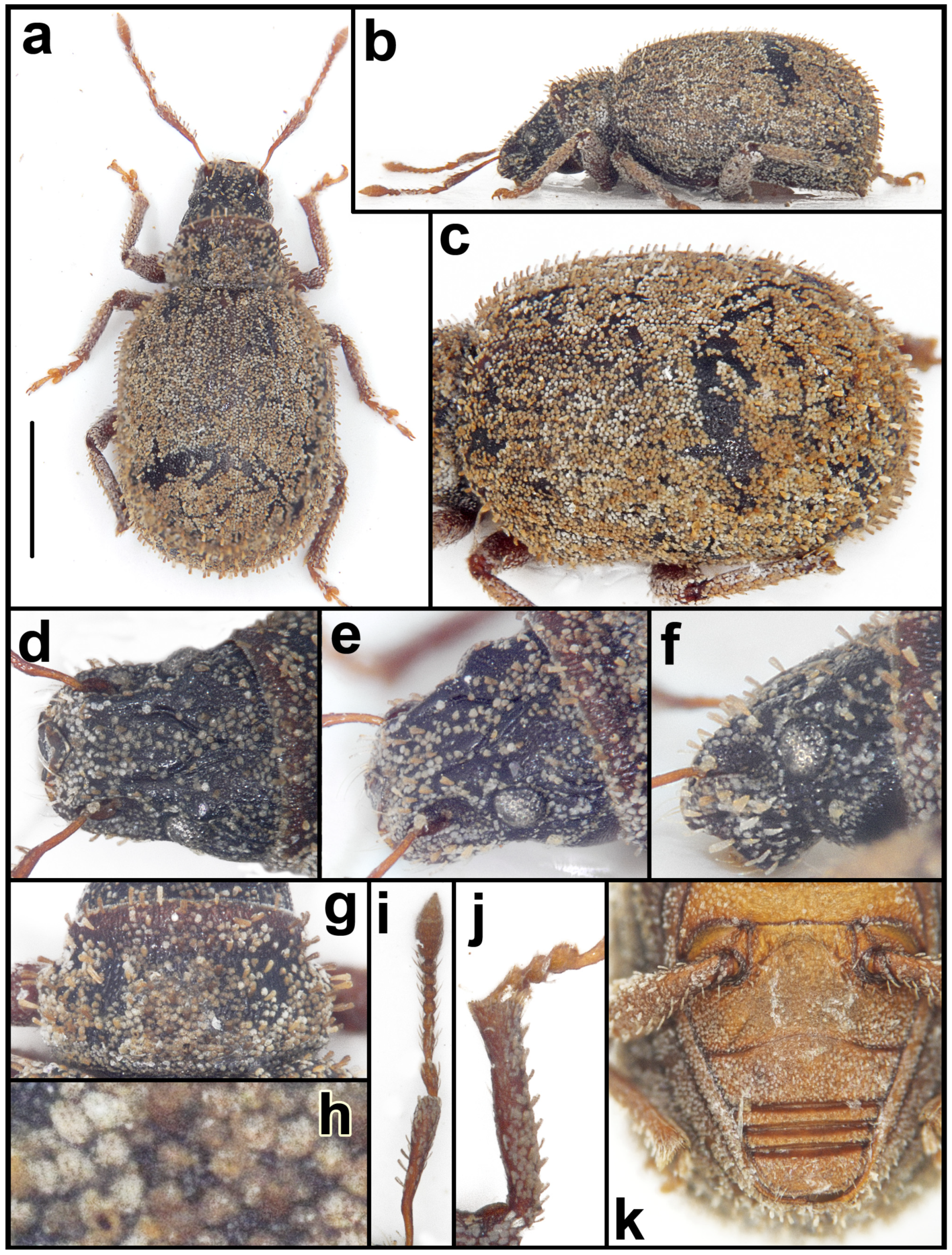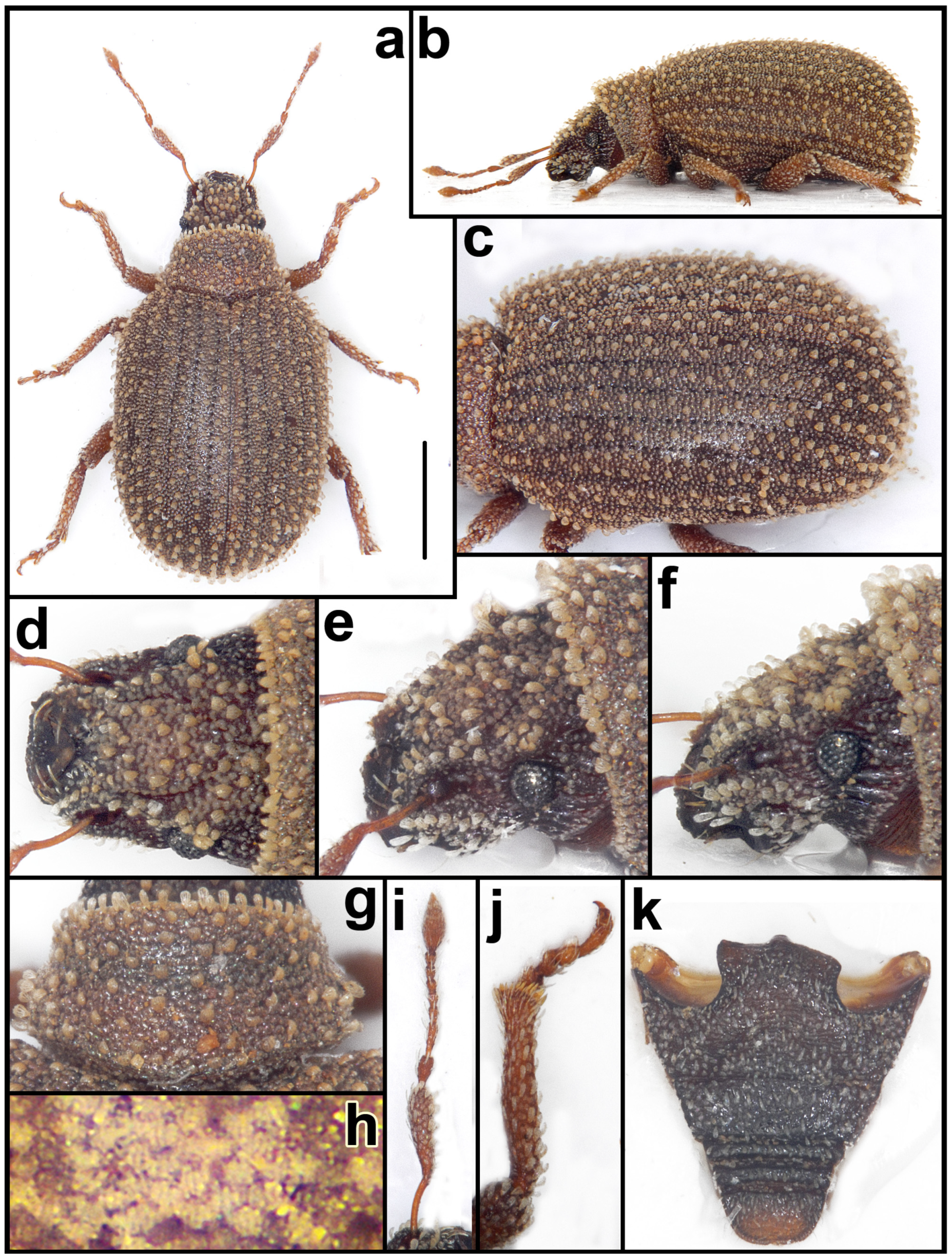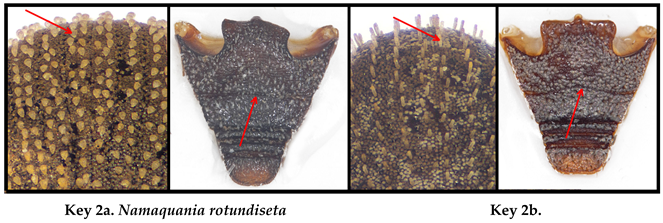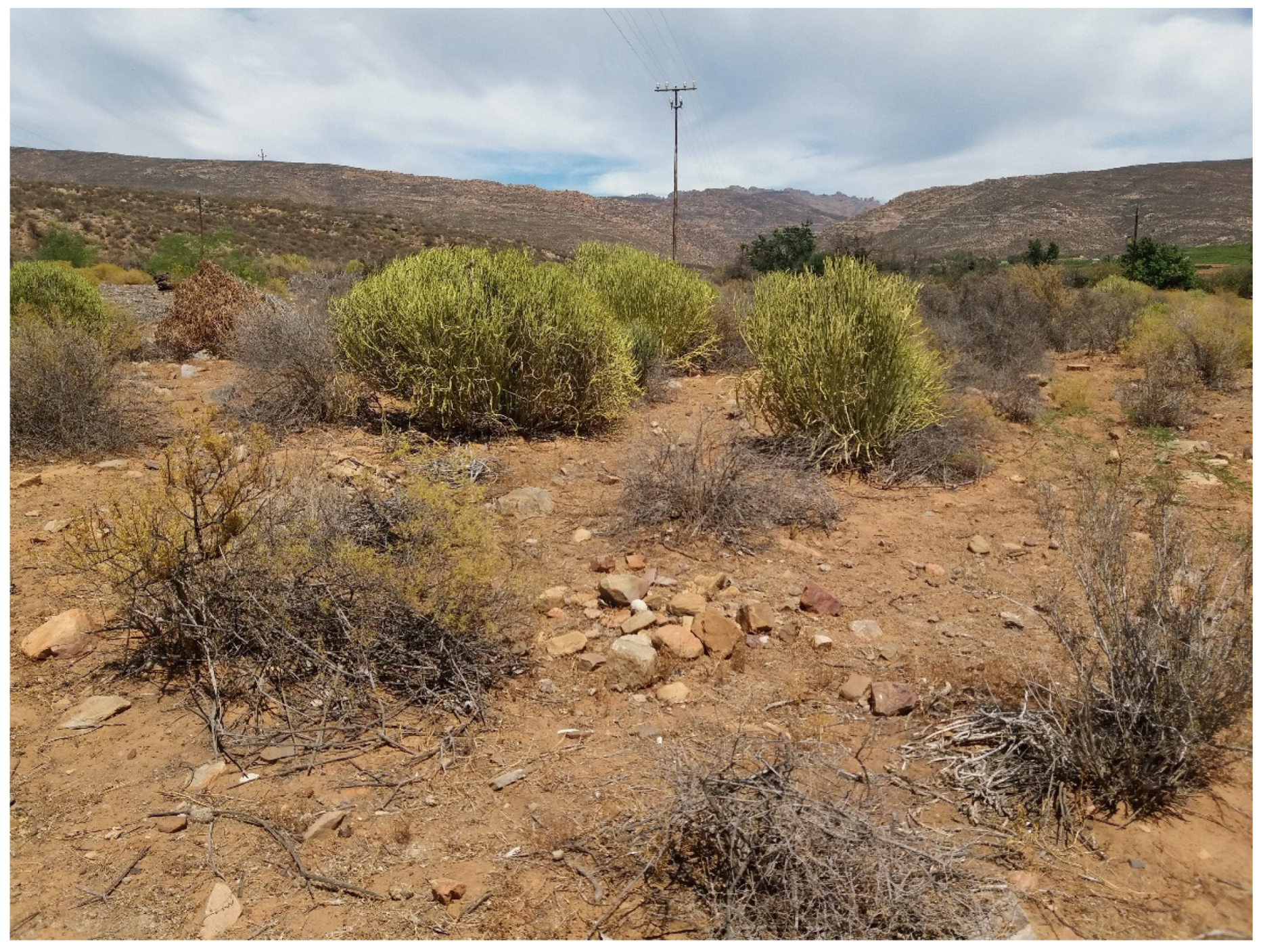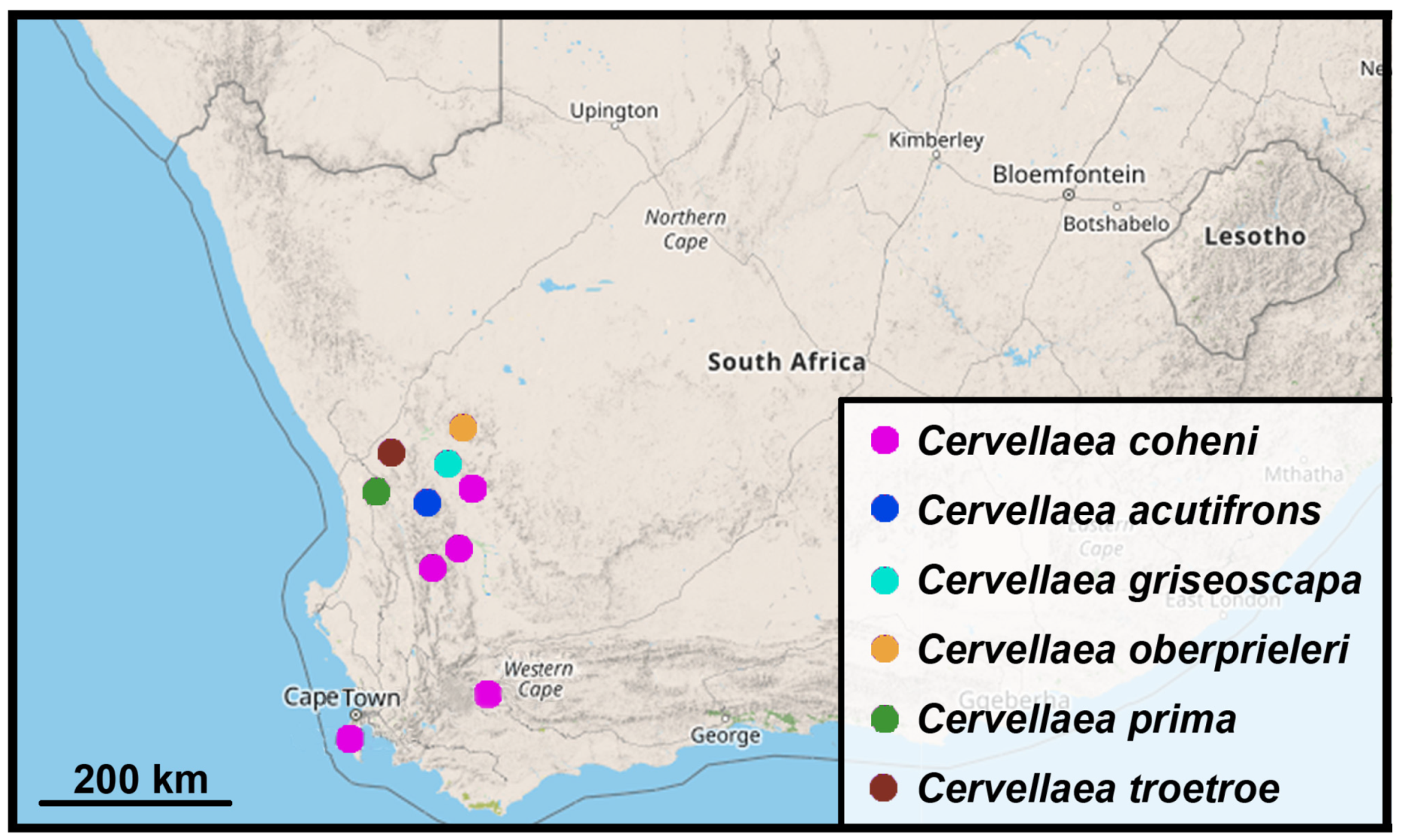3. Taxonomy
Cervellaea Borovec & Meregalli, in Meregalli et al., 2021: 9 (original description) [
3].
Biology. The specimens were usually found by sifting below large shrubs of
Euphorbia, often
E. mauritanica, where they shelter during the day and the dry season. The host plants of larvae and adults are not known
. The specimens of
Cervellaea were usually found in arid mesophytic slopes in Fynbos biome, with
Euphorbia and other grasses (
Figure 1 and
Figure 2).
Distribution. South Africa, Western Cape Province, and southern part of Northern Cape Province (
Figure 3).
Sexual dimorphism. External secondary sexual characters are not present in Cervellaea, with the exception of ventrite 5, which is shorter and obtuse in ♂ and longer, subtriangular in ♀. There is no size difference between the sexes.
Differential diagnosis. Cervellaea and Namaquania Borovec & Meregalli, 2021, differ from the other genera of Namaini by the antennal scrobes in lateral view sharply separated from the anterior margin of the eyes, the epifrons dorsally with a U-shaped stria, the subgena densely scaly, the gena densely scaly in the apical half, the ventral margin of the rostrum in lateral view short, and the procoxae placed at middle of the prosternum. Cervellaea differs from Namaquania by the antennal scrobes narrow in lateral view, slightly widened posteriad, with the ventral margin directed against the dorsal margin of the eye and the dorsal margin directed above the eye, and by the antennal scapes conspicuously widened at the apex, distinctly wider than the club.
Cervellaea coheni Borovec & Meregalli, in Meregalli et al., 2021: 9 (original description) [
3].
Type material. This species was described from two localities, both in Western Cape Province: Cederberg Mts., between Cederberg and Ceres, −32.062626° 19.39008°, 639 m, 24.xi.2016, and Cederberg Mts., Nuwerust Rest Camp entrance, −32.56203° 19.37678, 560 m, 13.xi.2018.
Additional material. 1 ♂, RSA, Western Cape, R 60 between Worcester & Robertson, −33.69475° 19.59670°, 292 m, 24.xi.2016, sifting of debris and dead leaves and branches below shrubby Euphorbia, R. Borovec, M. Meregalli lgt. (RBSC); 1 ♀, RSA, Western Cape, Cape Peninsula, Kommetjie, −34.13300° 18.33802°, 20 m, 26.xi.2016, evening sweeping of lawn, R. Borovec lgt. (RBSC); 1 ♂, RSA, Western Cape, Cederberg, S Varkloof Pass, −32.677130° 19.40937°, 666 m, 17.x.2019, sifting of litter under shrubby Euphorbia, R. Borovec, M. Meregalli lgt. (RBSC).
Redescription. Body length 2.88–3.44 mm. Body dark brownish, basal part of scapes, funicles with clubs, tibiae, and tarsi reddish brown. Body densely covered with rounded, weakly imbricated appressed scales, finely longitudinally striate, five–six across width of one interstria. Erect setae short, lanceolate, widest at midlength, apically pointed, about as long as a third to a quarter of one interstria width, forming one irregular row on each interstria. Pronotum and head including rostrum with identical setae, irregularly densely scattered. Inner side of scapes, femora and tibiae with short, erect, narrowly subspatulate setae. Vestiture dark brown, elytra marbled with small grey scales, pronotum with four inconspicuous, slender, irregular grey longitudinal stripes, rostrum grey.
Rostrum 1.58–1.71× as wide as long, widest at base, indistinctly tapered apicad with straight sides. Epifrons with distinctly concave sides, at base as wide as at apex.
Scrobes in lateral view with ventral margin directed towards middle of eye. Eyes small, in dorsal view hardly visible from outline of head, in lateral view with diameter slightly shorter than width of antennal scape at apex. Head with very small subtriangular tubercle above hind margin of eye, visible only in dorsolateral view.
Figure 4.
Cervellaea coheni Borovec & Meregalli, paratype. (a): body, dorsal view; (b): body, lateral view; (c): elytra, dorsolateral view; (d): head with rostrum, dorsal view; (e): head with rostrum, dorsolateral view; (f): head with rostrum, lateral view; (g): pronotum; (h): detail of vestiture of scales; (i): antenna; (j): protibia and protarsus; (k): ventrites. Bar: 1 mm.
Figure 4.
Cervellaea coheni Borovec & Meregalli, paratype. (a): body, dorsal view; (b): body, lateral view; (c): elytra, dorsolateral view; (d): head with rostrum, dorsal view; (e): head with rostrum, dorsolateral view; (f): head with rostrum, lateral view; (g): pronotum; (h): detail of vestiture of scales; (i): antenna; (j): protibia and protarsus; (k): ventrites. Bar: 1 mm.
Antennae with scape at basal third distinctly S-shaped, at apical two thirds distinctly evenly enlarged apicad, with straight sides, at apex 1.5–1.6× as wide as club. Segment 1 1.6–1.8× as long as wide and 1.1–1.2× as long as segment 2, this 1.8–2.0× as long as wide; segments 3 and 4 as wide as long; segment 5 and 6 1.1× as wide as long; segment 7 1.1–1.2× as wide as long; clubs 1.9–2.1× as long as wide.
Pronotum 1.68–1.84× as wide as long, moderately small in comparison to elytra, widest at basal third with distinctly rounded sides, at anterior third constricted. Elytra 1.29–1.38× as long as wide with slightly rounded sides; in lateral view slightly vaulted.
Protibiae at apex with fringe of black setae. Tarsi with segment 2 1.3× as wide as long; segment 3 1.4–1.5× as wide as long and 1.4–1.5× as wide as segment 2; onychium 1.6–1.7× as long as segment 3.
Suture between ventrites 1 and 2 slightly sinuate.
Spermatheca with cornu wide, distinctly tapered apicad, with tip curved; corpus large, rounded; ramus slightly longer than wide, straight, apically rounded; collum half long and wide in comparison to ramus, about as long as wide, parallel with ramus, placed in distance from it.
Biology. The type material was sifted from litter below big shrubs of Euphorbia.
Distribution. South Africa, Western Cape. This species has a rather wide range throughout the south-western part of Western Cape, down to Cape Peninsula (
Figure 1).
Differential diagnosis. Cervellaea coheni, with imbricate appressed elytral scales and a fringe of black setae at the apex of the protibiae, is similar to C. griseoscapa sp. n., from which it differs by the erect lanceolate, apically pointed elytral setae, forming an irregular row on each interstria, the funicular segment 2 long, and the spermatheca with ramus and collum short, parallel.
Zoobank: urn:lsid:zoobank.org:act:53217135-D1AB-4F46-A6AB-AF46C14A5146
Type locality. South Africa, Western Cape, Cederberg Mts. 3 km south of Wupperthal.
Type material. Holotype: ♂, RSA Western Cape Cederberg Mts. 3 km S Wupperthal −32.29588° 19.22738°, 500 m 22.xi.2016, sifting of debris, dead leaves and branches below shrubby
Euphorbia, R. Borovec, M. Meregalli lgt. (
Cervellaea sp. 467 [
3], supplementary files) (TMSA).
Paratypes: 23 specimens, same data as the holotype (MMTI, RBSC).
Description. Body length 2.94–3.59 mm, holotype 3.19 mm. Body dark brown, antennae and legs reddish brown, basal part of scapes, funicles with clubs and tarsi paler. Body densely covered with small, rounded, imbricate, finely longitudinally striate appressed scales, five–six across width of elytral interstria. Each elytral interstria with one irregular row of short, erect setae, widest at midlength, sharply apically pointed, about as long as half width of interstria, distance of two setae subequal to their length; pronotum and head including rostrum densely irregularly scattered with identical setae; inner side of scapes, femora and tibiae with short, dense, slender subspatulate setae. Elytral vestiture dark brown, marbled with small irregular grey spots; pronotum with irregular four longitudinal grey stripes; head including rostrum and scapes grey scaled.
Rostrum 1.73–1.83× as wide as long, subparallel-sided with straight sides; in lateral view regularly vaulted. Epifrons slightly enlarged apicad with straight sides, at apex slightly wider than at base, at base 0.6× as wide as rostrum in respective part. Antennal scrobes in lateral view with ventral margin directed towards middle of eye. Head above eyes with conspicuous, long and slender, spine-shaped prominences, distinctly prominent dorso-laterally. Eyes small, with diameter shorter than width of scape at apical part. Head behind eyes with longitudinal striae, converging towards median stria, giving head a striate appearance.
Scapes 4.6–4.8× as long as wide, in basal quarter distinctly curved, from here conspicuously evenly enlarged apicad, at apex 1.6–1.8× as wide as club. Funicles slender, segments 1 and 2 conical, 1 1.7–1.8× as long as wide and 1.2× as long as segment 2, this 1.8–2.0× as long as wide; segments 3 and 4 as long as wide; segments 5 and 6 1.1× as wide as long; segment 7 1.2× as wide as long; club 2.0–2.2× as long as wide.
Pronotum 1.58–1.67× as wide as long, widest shortly before base with distinctly curved sides, behind anterior margin slightly constricted; disc regularly domed. Elytra 1.27–1.32× as long as wide, subparallel-sided, apically broadly rounded; base slightly arched; striae narrow, hidden under scales; interstriae wide and flat; in lateral view slightly vaulted.
Figure 5.
Cervellaea acutifrons Borovec & Meregalli, sp. n., paratype. (a): body, dorsal view; (b): body, lateral view; (c): elytra, dorsolateral view; (d): head with rostrum, dorsal view; (e): head with rostrum, dorsolateral view; (f): head with rostrum, lateral view; (g): pronotum; (h): detail of vestiture of scales; (i): antenna; (j): protibia and protarsus; (k): ventrites. Bar: 1 mm.
Figure 5.
Cervellaea acutifrons Borovec & Meregalli, sp. n., paratype. (a): body, dorsal view; (b): body, lateral view; (c): elytra, dorsolateral view; (d): head with rostrum, dorsal view; (e): head with rostrum, dorsolateral view; (f): head with rostrum, lateral view; (g): pronotum; (h): detail of vestiture of scales; (i): antenna; (j): protibia and protarsus; (k): ventrites. Bar: 1 mm.
Tibiae 5.5–5.7× as long as wide at middle, apically with black setae. Tarsal segment 2 1.2–1.3× as wide as long; segment 3 1.4× as wide as long and 1.2–1.3× as wide as segment 2; onychium 1.4–1.6× as long as segment 3.
Ventrite 1 at middle longer than ventrites 2–4 together; ventrite 2 as long as ventrites 3 and 4 together; suture between ventrites 1 and 2 straight.
Penis short, widest at base, evenly tapered apicad with weakly rounded sides, apex narrowly pointed. Temones 2.7–2.9× as long as body of penis.
Spermatheca with cornu short, regularly curved; corpus elongated; ramus tube-shaped, straight, more than twice as long as wide, subparallel-sided; collum half as long as ramus and also narrower, slightly longer than wide, slightly curved. Sternite VIII with small oval plate and apodeme long and slender, terminated just at its base.
Derivation of the name. The Latin name, meaning “with pointed frons”, refers to the acute tubercles above the eyes.
Biology. Sifted in a sandy place near a small river below big shrubs of Euphorbia, together with Eremnus sp. (Entiminae, Tanyrhynchini) and Synthocus sp. (Brachycerinae, Brotheini).
Distribution. South Africa, Western Cape, Cederberg Mts.
Differential diagnosis. Cervellaea acutifrons sp. n. is easily separated from the other species of the genus by the slender and long tubercles on the head, directed dorsolaterally and well visible in lateral view. Only C. griseoscapa sp. n. has a very small, scarcely raised bump above eyes.
Zoobank: urn:lsid:zoobank.org:act:46991B55-D9AE-4A0B-A4B5-512D590958D9
Type locality. South Africa, Northern Cape, road 364 to Botterkloof Pass.
Type material. Holotype: ♂, RSA, Northern Cape, R 364 Botterkloof Pass, −31.80592° 19.26160°, 677 m, 22.xi.2016, sifting of debris, dead leaves and branches below shrubby
Euphorbia, R. Borovec, M. Meregalli lgt. (
Cervellaea sp. 463 [
3], supplementary files) (TMSA).
Paratypes: 32 specimens, same data as the holotype (NHMUK, MMTI, RBSC, SANC).
Description. Body length 2.78–3.89 mm, holotype 3.01 mm. Body dark brownish, basal portion of scapes, funicles with clubs and tarsi paler, reddish. Dorsal side of body densely covered with small, rounded, slightly imbricated, longitudinally finely striate appressed scales, five–six across width of one interstria. Each interstria with two irregular, dense rows of short, subspatulate, erect setae; setae apically truncated, widest at apex, about as long as one third of one interstria width, distance between two setae slightly longer than length of one seta. Pronotum and head including rostrum with identical, irregularly densely scattered setae; head with one–two erect scales above eyes; inner side of scapes and outer side of femora and tibiae with erect, short, subspatulate setae. Elytral vestiture brownish black, marbled with small grey spots; pronotum with four narrow longitudinal grey stripes; rostrum and scapes grey scaled.
Rostrum 1.68–1.82× as wide as long, subparallel-sided with straight sides. Epifrons with concave sides, equally wide at base as at apex, U-shaped stria inconspicuous. Head above eyes with a very small, scarcely raised bump. Scrobes in lateral view with ventral margin directed towards middle of eye. Eyes relatively large, in dorsal view prominent from outline of head, in lateral view with diameter subequal to width of scapes at apex.
Scapes at basal third S-shaped, in apical two thirds conspicuously evenly enlarged apicad, at apex 1.6–1.7× as wide as club. Segment 1 1.7–1.8× as long as wide and 1.6–1.8× as long as segment 2, this short, 1.3–1.5× as long as wide; segments 3 and 4 as long as wide; segments 5–7 1.2–1.3× as wide as long; clubs 2.0–2.1× as long as wide.
Pronotum 1.79–1.89× as wide as long. Elytra 1.31–1.36× as long as wide, parallel-sided; in lateral view flat.
Protibiae with fringe of short black setae at apex. Tarsi with segment 2 1.3–1.4× as wide as long; segment 3 1.4–1.5× as wide as long and 1.3–1.4× as wide as segment 2; onychium long, 1.7–1.9× as long as segment 3.
Ventrite 1 at middle longer than ventrites 2–4 together; suture between ventrites 1 and 2 straight.
Figure 6.
Cervellaea griseoscapa Borovec & Meregalli, sp. n., paratype. (a): body, dorsal view; (b): body, lateral view; (c): elytra, dorsolateral view; (d): head with rostrum, dorsal view; (e): head with rostrum, dorsolateral view; (f): head with rostrum, lateral view; (g): pronotum; (h): detail of vestiture of scales; (i): antenna; (j): protibia and protarsus; (k): ventrites. Bar: 1 mm.
Figure 6.
Cervellaea griseoscapa Borovec & Meregalli, sp. n., paratype. (a): body, dorsal view; (b): body, lateral view; (c): elytra, dorsolateral view; (d): head with rostrum, dorsal view; (e): head with rostrum, dorsolateral view; (f): head with rostrum, lateral view; (g): pronotum; (h): detail of vestiture of scales; (i): antenna; (j): protibia and protarsus; (k): ventrites. Bar: 1 mm.
Penis short, widest at base, evenly tapered apicad with straight sides, apically broadly rounded. Temones very long, 3.8–4.0× as long as body of penis.
Spermatheca with cornu straight; corpus slender, tube-shaped; ramus and nodulus slender, tube-shaped, straight, 2–3× as long as wide, ramus slightly longer than nodulus, V-shaped placed. Sternite VIII with small oval plate and apodeme terminating just at its base.
Derivation of the name. The antennal scapes covered by greyish appressed scales, paler than the remaining part of the body, suggested the name of this new species, from Latin griseus, grey, and scapus, scape.
Biology. The type material was sifted from litter below big shrubs of Euphorbia.
Distribution. South Africa, southern part of Northern Cape Province.
Differential diagnosis. This species differs from all other Cervellaea species by the elytral setae spatulate, apically truncated, widest at apex, forming two irregular dense rows on each interstria, the scapes with greyish appressed scales, paler than the remaining part of the antennae and the unusual shape of the spermatheca.
Zoobank: urn:lsid:zoobank.org:act:57457EF2-B43E-4293-A25B-9014F61AA1F9
Type locality. South Africa, Northern Cape, SE of Nieuwoudtville.
Type material. Holotype: ♂, South Africa, C. P. [Cape Province, now Northern Cape], 8–12 km SE Nieuwoudtville, 31.28S 19.18E [−31.47° 19.30°], 18.ix.1986, R. Oberprieler [lgt.], collected on
Chaetobromus dregeanus (
Cervellaea sp. 1 [
3], supplementary files) (SANC).
Paratypes: 5 specs., same data as the holotype (SANC).
Description. Body length 2.75–3.41 mm, holotype 3.02 mm. Body light brownish, antennae and legs pale, brown-yellowish. Body densely covered with small, isolated, round appressed scales, six–seven across width of one interstria. Erect setae on elytra short, about as long as one quarter of one interstria width, slender, evenly enlarged apicad, apically truncate, forming one irregular row on each interstria, two irregular rows on interstriae 3 and 5. Setae on pronotum and head including rostrum identical, densely irregularly scattered; inner side of scapes and outer sides of femora and tibiae with short, semi-erect, slender setae.
Rostrum 1.62–1.68× as wide as long, widest at base and here in short distance weakly tapered anteriad, then subparallel-sided. Epifrons widest at base, in basal third distinctly tapered anteriad, then slightly enlarged anteriad again. Antennal scrobes in lateral view with ventral margin directed against middle of eye. Eyes in dorsal view hardly prominent from outline of head; in lateral view with diameter subequal to width of antennal scape.
Antennal scapes at basal third S-shaped, very slender, then evenly enlarged apicad, at apex more than 2× as wide than at point of curvature. Segment 1 1.7–1.9× as long as wide and 1.4–1.5× as long as segment 2, this 1.6–1.7× as long as wide; segment 3 1.1–1.2× as long as wide; segments 4 and 5 as long as wide; segment 6 1.1× as wide as long; segment 7 1.2× as wide as long; club 2.1–2.2× as long as wide.
Pronotum somewhat slender, 1.61–1.68× as wide as long, small in comparison to elytra, widest before base, with rounded sides, constricted behind anterior margin. Elytra 1.32–1.39× as long as wide, subparallel-sided; in lateral view flat.
Protibiae apically fringed with yellowish setae. Tarsi with segment 2 1.2× as wide as long; segment 3 1.3–1.4× as wide as long and 1.4–1.5× as wide as segment 2; onychium 1.5–1.6× as long as segment 3.
Suture between ventrites 1 and 2 straight.
Penis long and slender, subparallel-sided, apex regularly rounded. Temones very long, 3.5–3.6× as long as body of penis.
Spermatheca not examined.
Derivation of the name. This species is named after our friend Rolf G. Oberprieler from CSIRO Ecosystem Sciences, Canberra, Australia, eminent specialist of Curculionoidea of Australia and South Africa, who collected the type material.
Biology. The type material was collected on Chaetobromus involucratus subsp. dregeanus (Nees) Verboom (Poaceae).
Figure 7.
Cervellaea oberprieleri Borovec & Meregalli, sp. n., paratype. (a): body, dorsal view; (b): body, lateral view; (c): elytra, dorsolateral view; (d): head with rostrum, dorsal view; (e): head with rostrum, dorsolateral view; (f): head with rostrum, lateral view; (g): pronotum; (h): detail of vestiture of scales; (i): antenna; (j): protibia and protarsus; (k): ventrites. Bar: 1 mm.
Figure 7.
Cervellaea oberprieleri Borovec & Meregalli, sp. n., paratype. (a): body, dorsal view; (b): body, lateral view; (c): elytra, dorsolateral view; (d): head with rostrum, dorsal view; (e): head with rostrum, dorsolateral view; (f): head with rostrum, lateral view; (g): pronotum; (h): detail of vestiture of scales; (i): antenna; (j): protibia and protarsus; (k): ventrites. Bar: 1 mm.
Distribution. South Africa, southern part of Northern Cape Province.
Differential diagnosis. Cervellaea oberprieleri sp. n. differs from the other species of the genus by the slender, parallel-sided elytra, in lateral view flat and unicoloured and the brown-yellowish antennae and legs. It shares the isolated appressed elytral scales and yellow setae at the apex of the protibiae with C. prima sp. n., from which it also differs by the single irregular row of erect setae on the even interstriae and the scape more than 2× as wide at apex than at point of curvature.
Zoobank: urn:lsid:zoobank.org:act:7536F617-48DA-45AA-8523-D73ACF2E1C50
Type locality. South Africa, Western Cape, ca 40 km SW of Vanrhynsdorp.
Type material. Holotype: ♂, RSA, Western Cape, Ca 40 km SW Vanrhynsdorp, 35 km S Trawal, rd N7, −31.91469°, 18.52764° 9.ix.2013, 65 m, sifting of debris, dead leaves and branches below shrubby
Euphorbia, R. Borovec, M. Meregalli lgt. (
Cervellaea sp. 309 [
3], supplementary files) (TMSA).
Paratypes: 43 specs., same data as the holotype (NHMUK, MMTI, RBSC, SANC).
Description. Body length 2.97–3.69 mm, holotype 3.54 mm. Body dark brownish, base of scapes, funicles with clubs, short apical parts of femora and tibiae reddish brown, tarsi brown-yellowish. Body densely covered with small, isolated, round appressed scales, seven–eight across width of one interstria. Erect setae short, parallel-sided, apically truncated, apex shallowly concave, forming two–three irregular rows on each interstria, twice as long as diameter of one scale; setae on pronotum and head including rostrum identical, densely, irregularly scattered; setae on inner side of scapes and inner margin of femora and tibiae short, narrowly subspatulate. Vestiture on elytra and rostrum grey, on elytra marbled with irregular brown spots, on pronotum brown with four longitudinal stripes.
Rostrum short and wide, 1.77–1.82× as wide as long, subparallel-sided. Epifrons with concave sides, slightly wider at base than at apex. Scrobes in lateral view with ventral margin directed towards middle of eye. Eyes relatively large, in dorsal view prominent from outline of head, in lateral view with diameter subequal to width of scape at apex.
Scapes at base very slender, S-shaped at basal third, then evenly enlarged apicad with straight sides, at apex 1.5–1.6× as wide as at point of curvature. Segments 1 and 2 slender, long, conical, segment 1 2.4–2.8× as long as wide and 1.3–1.4× as long as segment 2, this 2.1–2.2× as long as wide; segment 3 1.2–1.3× as long as wide; segment 4 1.1× as long as wide; segments 5 and 6 as long as wide; segment 7 1.1–1.2× as wide as long; clubs 2.2–2.2× as long as wide.
Pronotum 1.76–1.89× as wide as long, small in comparison to elytra, widest at basal third and here distinctly rounded, constricted in anterior third. Elytra 1.19–1.27 as long as wide, subparallel-sided along entire length, laterally feebly vaulted.
Protibiae at apex with fringe of fine yellowish, translucent setae. Tarsi with segment 2 1.1–1.2× as wide as long; segment 3 1.3–1.4× as wide as long and 1.5× as wide as segment 2; onychium long, 1.7–1.8× as long as segment 3.
Ventrites with segment 1 as long as 2–4 together; suture between ventrites 1 and 2 straight.
Penis moderately long and slender, widest before base, evenly tapered apicad with straight sides, apex subtriangular. Temones 2.8–3.0× as long as body of penis.
Spermatheca with cornu almost straight, with curved tip; corpus elongate; ramus straight, about twice as long as wide; collum much smaller than ramus, hump-shaped, parallel with it and placed at short distance from it.
Figure 8.
Cervellaea prima Borovec & Meregalli, sp. n., paratype. (a): body, dorsal view; (b): body, lateral view; (c): elytra, dorsolateral view; (d): head with rostrum, dorsal view; (e): head with rostrum, dorsolateral view; (f): head with rostrum, lateral view; (g): pronotum; (h): detail of vestiture of scales; (i): antenna; (j): protibia and protarsus; (k): ventrites. Bar: 1 mm.
Figure 8.
Cervellaea prima Borovec & Meregalli, sp. n., paratype. (a): body, dorsal view; (b): body, lateral view; (c): elytra, dorsolateral view; (d): head with rostrum, dorsal view; (e): head with rostrum, dorsolateral view; (f): head with rostrum, lateral view; (g): pronotum; (h): detail of vestiture of scales; (i): antenna; (j): protibia and protarsus; (k): ventrites. Bar: 1 mm.
Derivation of the name. The specific epithet of the new species is derived from the Latin word primus, first, because this was the first species of the genera Cervellaea and Namaquania that we collected. It was also our first experience of collecting Namaini by sifting litter below large shrubs of Euphorbia.
Biology. The type material was sifted from debris below large shrubs of Euphorbia.
Distribution. South Africa, Western Cape.
Differential diagnosis. Cervellaea prima sp. n. resembles C. oberprieleri sp. n. for the isolated appressed elytral scales and the protibiae fringed at apex with yellow setae. It differs by the short and wide, in lateral view vaulted, elytra, all the interstriae with two–three irregular rows of erect setae and the scape moderately broadened apicad.
Zoobank: urn:lsid:zoobank.org:act:405D06C0-AF42-4884-86C4-17C0484DABC3
Type locality. South Africa, Western Cape, 1 km SE of Vanrhynsdorp.
Type material. Holotype: ♂, RSA, Western Cape, 1 km SE Vanrhynsdorp, −31.62056° 18.72802°, 117 m, 10.ix.2013, sifting of debris, dead leaves and branches below shrubby
Euphorbia, R. Borovec, M. Meregalli lgt. (
Cervellaea sp. 310 [
3], supplementary files) (TMSA).
Paratypes: 3 ♀♀, same data as the holotype (MMTI, RBSC).
Description. Body length 2.25–2.68 mm, holotype 2.25 mm. Body black, apical half of antennal scapes and femora blackish, contrasting brown-yellowish basal part of scape, funicles with clubs and tibiae with tarsi. Appressed elytral scales small, reciprocally isolate, five–six across width of one interstria. Semi-erect setae on dorsal part of body shortly oval, apically rounded, only slightly longer and wider than one appressed scale, forming one moderately dense row on each interstria, densely scattered on pronotum and head including rostrum, distance between two setae on elytra about twice as long as length of one seta. Scapes, femora and tibiae sparsely covered with small, slender, long oval appressed setae and with inconspicuous, very short, narrowly subspatulate semi-erect setae.
Figure 9.
Cervellaea troetroe Borovec & Meregalli, sp. n., paratype. (a): body, dorsal view; (b): body, lateral view; (c): elytra, dorsolateral view; (d): head with rostrum, dorsal view; (e): head with rostrum, dorsolateral view; (f): head with rostrum, lateral view; (g): pronotum; (h): detail of vestiture of scales; (i): antenna; (j): protibia and protarsus; (k): ventrites. Bar: 1 mm.
Figure 9.
Cervellaea troetroe Borovec & Meregalli, sp. n., paratype. (a): body, dorsal view; (b): body, lateral view; (c): elytra, dorsolateral view; (d): head with rostrum, dorsal view; (e): head with rostrum, dorsolateral view; (f): head with rostrum, lateral view; (g): pronotum; (h): detail of vestiture of scales; (i): antenna; (j): protibia and protarsus; (k): ventrites. Bar: 1 mm.
Vestiture of body light brown, lateral parts of elytra and pronotum grey, entire rostrum grey. Rostrum 1.41–1.50× as wide as long, at basal quarter tapered anteriad, then subparallel-sided. Epifrons widest at base, distinctly tapered anteriad at basal half and weakly enlarged anteriad at apical half. Scrobes in lateral view with dorsal margin directed towards dorsal margin of eye, ventral margin directed towards ventral margin of eye. Eyes relatively large, in dorsal view protruding from outline of head, more in males than in females. Head in lateral view lacking longitudinal striae behind and below eyes.
Scapes at basal third slender, S-shaped, in apical two thirds distinctly evenly enlarged, in males more than in females, in males 1.7× as wide as clubs, in females 1.5× as wide as clubs. Funicle segment 1 1.8–2.0× as long as wide and 1.9–2.1× as long as short segment 2, this 1.1–1.3× as long as wide; segment 3 as long as wide; segment 4 1.1 as wide as long; segment 5 1.3–1.4× as wide as long; segment 6 1.5–1.6× as wide as long; segment 7 1.7–1.8× as wide as long; club 1.9–2.1× as long as wide.
Pronotum narrow, 1.53–1.59× as wide as long, moderately small in comparison to elytra, widest before base, with rounded sides, evenly tapered apicad. Elytra oval, 1.29–1.31× as long as wide, with regularly rounded sides; in lateral view vaulted.
Protibiae apically narrow, rounded, with fringe of short and fine, translucent setae. Tarsi with segment 2 1.2–1.3× as wide as long; segment 3 1.3–1.4× as wide as long and 1.5–1.6× as wide as segment 3; onychium 1.3–1.4× as long as segment 3.
Suture between ventrites 1 and 2 straight.
Figure 10.
Outline of penis and sclerites of internal sac of (a): Cervellaea coheni; (b): C. acutifrons; (c): C. griseoscapa; (d): C. oberprieleri; (e): C. prima; (f): C. troetroe. Outline of spermatheca of (g): Cervellaea prima; (h): C. troetroe; (i): C. coheni; (j): C. acutifrons; (k): C. griseoscapa. Gonocoxites of (l): Cervellaea coheni. Sternum VIII of (m): Cervellaea coheni. Bars: (a–f); m: 500 μm; (g–l): 250 μm.
Figure 10.
Outline of penis and sclerites of internal sac of (a): Cervellaea coheni; (b): C. acutifrons; (c): C. griseoscapa; (d): C. oberprieleri; (e): C. prima; (f): C. troetroe. Outline of spermatheca of (g): Cervellaea prima; (h): C. troetroe; (i): C. coheni; (j): C. acutifrons; (k): C. griseoscapa. Gonocoxites of (l): Cervellaea coheni. Sternum VIII of (m): Cervellaea coheni. Bars: (a–f); m: 500 μm; (g–l): 250 μm.
Penis short, widest at base, evenly tapered apicad with straight sides, apex regularly rounded. Temones 2.4× as long as body of penis.
Spermatheca with cornu short, wide, regularly curved; corpus rounded; ramus small, about as long as wide, slightly tapered apicad; nodulus subtriangular, slightly larger than ramus.
Derivation of the name. The species is named after the original name of Vanrhynsdorp, TroeTroe, which was founded when the area was first explored by Europeans in 1661.
Biology. The type material was sifted from litter below big shrubs of Euphorbia.
Distribution. South Africa, Western Cape.
Differential diagnosis. Cervellaea troetroe sp. n. differs from the others species of the genus by the following set of unique characters: small size, less than 2.7 mm, integument blackish, femora blackish, contrasting with the brown-yellowish tibiae, temples without striae, narrow pronotum and funicle segments 6 and 7 1.5–1.8× as wide as long.
1a. Head above eyes with long and slender spine-shaped tubercle, distinctly prominent dorsolaterally.
Size 2.9–3.6 mm. ……………………………… …………………………………Cervellaea acutifrons sp. n. |
| 1b. Head above eyes without tubercle, at most with a microscopic bump ……………………………… 2 |
2a. Smaller, 2.2–2.7 mm. Head in lateral view without longitudinal striae. Integument of body blackish. Femora
and anterior half of scapes blackish, contrasting from brown-yellowish funicles and tibiae with tarsi. Spermatheca
with ramus as long as wide and nodulus subtriangular ……………………………………… Cervellaea troetroe sp. n. |
2b. Larger, at least 2.9 mm long. Head in lateral view distinctly striolate. Integument of body light to dark brownish.
Femora and tibiae equally brownish. Spermatheca with ramus and nodulus tube-shaped, longer than wide ……….. 3 |
| 3a. Appressed elytral scales isolated. Setae at apex of protibiae yellow ………………………………………… 4 |
| 3b. Appressed elytral scales imbricated. Setae at apex of protibiae grey ………………………………………… 5 |
4a. Elytra short, 1.19–1.27× as long as wide, in lateral view vaulted. All interstriae with two–three irregular
rows of erect setae. Scapes moderately broadened, at apex 1.5× as wide as at point of curvature; funicle
segments long and slender. Size 3.0–3.7 mm …………………………………………… Cervellaea prima sp. n. |
4b. Elytra longer, 1.32–1.39× as long as wide, in lateral view flat. Odd interstriae with a single row of erect
setae. Scapes strongly broadened, at apex more than 2× as wide as at point of curvature; funicle segments
short. Size 2.7–3.4 mm…………………………………………………………………Cervellaea oberprieleri sp. n. |
![Taxonomy 05 00014 i004 Taxonomy 05 00014 i004]()
5a. Erect setae on pronotum and elytra truncated. Scapes with greyish appressed scales, paler than remaining
part of antennae and legs. Funicle segments short and compact, segment 2 1.5× as long as wide. Temones very
long, 3.8–4.0× as long as body of penis. Spermatheca with corpus elongated, ramus and nodulus slender,
tube-shaped, 2–3× as long as wide, V-shaped placed. Size 3.4–3.9 mm ………….. Cervellaea griseoscapa sp. n. |
5b. Erect setae on pronotum and elytra lanceolate, apically pointed. Scapes with dark brown appressed scales;
funicle segment well isolated, segment 2 almost 2× as long as wide. Temones shorter, 2.5–2.6× as long as body of
penis. Spermatheca with corpus rounded, ramus slightly longer than wide, collum short, as long as wide, both
parallel. Size 2.9–3.4 mm ……………………………………………… Cervellaea coheni Borovec & Meregalli, 2021 |
Namaquania Borovec & Meregalli, in Meregalli et al., 2021: 11 (original description) [
3].
Biology. The specimens were usually found by sifting below large
Euphorbia shrubs, usually
E. maritanica and occasionally
E. dregeana, where they sheltered during the day and the dry season. Host plants of larvae and adults are not known. The habitats in which
Namaquania specimens were found are semi-desert rocky slopes with sandy soil, in Succulent Karoo biome, with dominant Aizoaceae and large
Euphorbia shrubs (
Figure 11 and
Figure 12).
Distribution. South Africa, northern part of Northern Cape Province (
Figure 13).
Sexual dimorphism. External secondary sexual characters are not present in Namaquania, with the exception of ventrite 5, which is shorter and obtuse in ♂and longer, subtriangular in ♀. There is no size difference between the sexes.
Differential diagnosis. The genus Namaquania shares with Cervellaea the antennal scrobes in lateral view sharply separated by a broad scaly stripe from the anterior margin of the eyes, the epifrons dorsally with a U-shaped stria, the subgena densely scaly, the gena densely scaly in the apical half, the ventral margin of the rostrum in lateral view short and the procoxae placed in the middle of the prosternum. These characters allow these genera to be separated from the other genera of Namaini. Namaquania differs from Cervellaea by the antennal scrobes wide in lateral view, distinctly enlarged posteriad, with the ventral margin directed against the ventral margin of the eye and the dorsal margin directed against the dorsal margin of the eye, and by the antennal scapes only slightly widened at the apex, at most as wide as the club.
Namaquania andreai Borovec & Meregalli, in Meregalli et al., 2021: 11 (original description) [
3].
Type locality. South Africa, Northern Cape, 20 km S Eksteeinfontein above Ratelfontein.
Type material. Species described from two localities, very close to each other: Northern Cape, 20 km S Eksteeinfontein above Ratelfontein, −28.95663° 17.33436°, 16.ix.2013, 805 m and Northern Cape, 20 km S Eksteeinfontein, E Ratelfontein, −28.95029° 17.35013°, 16.ix.2013, 690 m.
Additional material. 11 specs., RSA, Northern Cape, rd from R 382 Ecksteinfontein, −28.97359° 17.37156°, 553 m, 16.xi.2016, sifting of debris, dead leaves and branches below shrubby
Euphorbia, R. Borovec, M. Meregalli lgt. (
Namaquania sp. 438: [
3], supplementary files) (MMTI, RBSC); 3 specs., RSA, Northern Cape, NE Eksteeinfontein, Pass E Jenkinskopf, −28.69353° 17.27599°, 17.ix.2013, 640 m, sifting of debris, dead leaves and branches below shrubby
Euphorbia, R. Borovec, M. Meregalli lgt. (
Namaquania sp. 339 [
3], supplementary files) (MMTI, RBSC); 1 spec., RSA, Northern Cape, NW Eksteinfontein, −28.79993° 17.22990°, 16.ix.2016, 712 m, R. Borovec lgt. (RBSC).
Redescription. Body length 2.33–3.38 mm. Body brown to dark brown, entire antennae and legs yellowish red, only femora in some specimens darker. Appressed scales on dorsal part of body small, regularly rounded, isolated, dense, six–seven across width of one interstria. Erect setae distinct, as long as half width of interstria, narrowly subtriangular, widest at apex and here truncate, forming one regular dense row on each interstria, exceptionally two irregular rows on interstriae 3 and 5, on pronotum and head including rostrum identical, densely regularly scattered. Scapes, femora and tibiae densely covered with smaller, rounded appressed scales and erect, short, narrowly subspatulate setae. Elytral vestiture dark brown, marbled with small, grey spots, pronotum dark brown with four longitudinal grey stripes, rostrum grey.
Rostrum 1.71–1.78× as wide as long, widest at base, weakly regularly tapered apicad with straight sides, at base 1.06–1.11× as wide as at apex. Epifrons wide, weakly wider at base than at apex, with distinctly concave sides. Scrobes in lateral view with dorsal margin directed towards middle of eye and ventral margin directed tightly below ventral margin of eye. Eyes small, vaulted, in dorsal view hardly prominent from outline of head. Head behind eyes in dorsal view with dense longitudinal striae.
Antennae slender; scapes weakly curved at basal third, then weakly evenly enlarged apicad, at apex as wide as clubs. Segment 2 1.1× as long as segment 1; segment 1 2.1–2.2× as long as wide; segment 2 2.8–3.2× as long as wide; segment 3 1.2–1.3× as long as wide; segment 4 1.1–1.2× as long as wide; segments 5 and 6 as long as wide to 1.1× as long as wide; segment 7 as long as wide; clubs 2.4–2.6× as long as wide.
Figure 14.
Namaquania andreai Borovec & Meregalli, 2021, paratype. (a): body, dorsal view; (b): body, lateral view; (c): elytra, dorsolateral view; (d): head with rostrum, dorsal view; (e): head with rostrum, dorsolateral view; (f): head with rostrum, lateral view; (g): pronotum; (h): detail of vestiture of scales; (i): antenna; (j): protibia and protarsus; (k): ventrites. Bar: 1 mm.
Figure 14.
Namaquania andreai Borovec & Meregalli, 2021, paratype. (a): body, dorsal view; (b): body, lateral view; (c): elytra, dorsolateral view; (d): head with rostrum, dorsal view; (e): head with rostrum, dorsolateral view; (f): head with rostrum, lateral view; (g): pronotum; (h): detail of vestiture of scales; (i): antenna; (j): protibia and protarsus; (k): ventrites. Bar: 1 mm.
Pronotum 1.71–1.79× as wide as long, constricted before midlength, at basal half with distinctly rounded sides; in lateral view slightly vaulted at basal half, flattened behind anterior margin. Elytra long oval, 1.31–1.38× as long as wide, with slightly rounded sides; in lateral view weakly vaulted.
Protibiae with lateral margin straight, apically fringed with fine yellow setae. Tarsi with segment 2 1.1–1.2× as wide as long; segment 3 1.4–1.5× as wide as segment 2 and 1.4–1.5× as wide as segment 2; onychium 1.6–1.7× as long as segment 2.
Ventrites with segment 1 as long as ventrites 2–4; suture between ventrites 1 and 2 slightly sinuate.
Penis short, widest at base, evenly tapered apicad, tip narrowly rounded. Temones 1.7–1.9× as long as body of penis.
Spermatheca with cornu short, regularly curved; corpus rounded; ramus longer than wide, apically rounded; collum subtriangular, slightly shorter and distinctly narrower than ramus.
Biology. The type material was sifted from litter under big, shrubby Euphorbia plants.
Distribution. South Africa, Northern Cape.
Differential diagnosis. Namaquania andreai, with slender erect setae distinctly longer than wide, somewhat parallel-sided, resembles N. inopinata sp. n., from which it differs by the longer elytral erect setae forming one regular row and the funicle segment 2 longer than segment 1.
Zoobank: urn:lsid:zoobank.org:act:E37ED7EF-3919-42C3-A14C-A00801B44264
Type locality. South Africa, Northern Cape, ca. 20 km W Eksteeinfontein.
Type material. Holotype: ♂, RSA, Northern Cape, rd Kuboes-Eksteeinfontein, ca. 20 km W Eksteeinfontein, −28.76518°, 17.15474°, 23.ix.2013, 435 m, R. Borovec, M. Meregalli lgt. (
Namaquania sp. 355 [
3], supplementary files) (TMSA).
Paratypes: 1 ♂ 2 ♀, same data as holotype (MMTI, RBSC).
Description. Body length 2.69–3.34 mm, holotype 2.69 mm. Body dark brown; antennae and legs paler, reddish brown. Appressed scales on dorsal part of body small, regularly rounded, finely longitudinally striate, six–seven across width of interstria. Semi-erect setae on elytra very short, inconspicuous, rounded, as long as wide, subequal in size to one appressed scale, forming one regular row on each interstria, visible mainly in lateral view. Semi-erect setae on pronotum and head including rostrum slightly longer than wide, subspatulate, slightly longer than elytral setae. Scapes, femoraand tibiae with small, regular, dense appressed scales; scapes at inner side with erect, somewhat long, narrowly subspatulate setae; femora and tibiae on outer side with short, inconspicuous, semi-appressed, narrowly subspatulate setae. Elytral vestiture light brown with irregularly scattered small light grey spots; pronotum light brown with four longitudinal light grey to whitish stripes; rostrum mainly whitish.
Rostrum 1.73–1.77× as wide as long, widest at base, slightly tapered apicad with straight sides, at base 1.12–1.19× as wide as at apex. Epifrons with concave sides, narrowest in middle, at base slightly wider than at apex. Scrobes in lateral view with dorsal margin directed towards middle of eye and ventral margin directed towards ventral margin of eye. Eyes small, vaulted, in dorsal view hardly prominent from outline of head. Head behind eyes with slender median longitudinal stria.
Antennae slender; scapes curved at basal third, then weakly evenly enlarged apicad, at apex as wide as clubs. Segment 1 2.1–2.2× as long as wide and as long as segment 2, this 3.0–3.2× as long as wide; segment 3 1.3–1.4× as long as wide; segment 4 and 5 1.2× as long as wide; segment 6 1.1× as long as wide; segment 7 as long as wide; clubs 1.9–2.2× as long as wide.
Figure 15.
Namaquania basteriana Borovec & Meregalli, sp. n., paratype. (a): body, dorsal view; (b): body, lateral view; (c): elytra, dorsolateral view; (d): head with rostrum, dorsal view; (e): head with rostrum, dorsolateral view; (f): head with rostrum, lateral view; (g): pronotum; (h): detail of vestiture of scales; (i): antenna; (j): protibia and protarsus; (k): ventrites. Bar: 1 mm.
Figure 15.
Namaquania basteriana Borovec & Meregalli, sp. n., paratype. (a): body, dorsal view; (b): body, lateral view; (c): elytra, dorsolateral view; (d): head with rostrum, dorsal view; (e): head with rostrum, dorsolateral view; (f): head with rostrum, lateral view; (g): pronotum; (h): detail of vestiture of scales; (i): antenna; (j): protibia and protarsus; (k): ventrites. Bar: 1 mm.
Pronotum 1.61–1.66× as wide as long, moderately small in comparison to elytra, constricted before midlength, with rounded sides in basal half; in lateral view weakly vaulted, flattened behind anterior margin. Elytra oval, 1.21–1.29× as long as wide, with regularly rounded sides; in lateral view vaulted.
Protibiae with lateral margin straight, at apex rounded with fringe of stout brown setae. Tarsi with segment 2 1.2–1.3× as wide as long; segment 3 1.4× as wide as long and 1.4–1.5× as wide as segment 2; onychium 1.6–1.7× as long as segment 3.
Ventrite 1 as long as ventrites 2–4; suture between ventrites 1 and 2 slightly sinuate.
Penis at basal half subparallel-sided, then evenly tapered apicad with rounded apex. Temones 1.6–1.8× as long as body of penis.
Spermatheca with cornu short, regularly curved; corpus large, rounded; ramus as long as wide, rounded; collum very small, hump-shaped, as long as wide, conspicuously shorter and narrower than ramus.
Derivation of the name. The Basters (also known as Baasters, Rehobothers, or Rehoboth Basters) are a Southern African ethnic group descended from Cape Coloureds and Nama of Khoisan origin. They live now in Namibia and Northern Cape Province [
8].
Biology. The type material was sifted from debris below shrubby Euphorbia plants.
Distribution. South Africa, Northern Cape.
Differential diagnosis. Namaquania basteriana sp. n. is easily distinguishable from the other species of the genus by the inconspicuous, very small semi-erect setae on the entire dorsal part of the body.
Zoobank: urn:lsid:zoobank.org:act:F6C33FFB-660F-4CED-9258-9C8DABAA7B71
Type locality. South Africa, Northern Cape, ca 10 km N Port Nolloth.
Type material. Holotype: ♂, RSA, Northern Cape, Port Nolloth ca 10 km N, R382 to Lekkersing, −29.25456° 17.10913°, 18.ix.2013, 150 m, R. Borovec, M. Meregalli lgt. (
Namaquania sp. 340 [
3], supplementary files) (TMSA).
Paratypes: 6 ♂♂ 3 ♀♀, same data as holotype (MMTI, RBSC); 7 specs., S. Afr., Richtersveld, Upper Holgat, 28.43S–17.07E [−28.72° 17.12°] 7.9.1976; E-Y: 1232, groundtraps 33 days, groundtrap with banana bait, leg. Endrödy-Younga (
Namaquania sp. 1 [
3], supplementary files) (TMSA).
Description. Body length 2.51–3.36 mm, holotype 2.75 mm. Body dark brown, entire antennae and legs brown-yellowish, only femora in some specimens darker. Body with small, regularly rounded, isolated appressed scales, six–seven across width of one interstria. Each interstria with two irregular rows of dense erect setae, narrowly subtriangular, widest at apex and here truncated, at posterior declivity slightly shorter than half width of one interstria. Erect setae on pronotum and head including rostrum identical, densely irregularly scattered. Semi-erect setae on inner side of scapes and outer side of femora and tibiae short, very slender. Elytral vestiture brownish, elytra marbled with numerous small, irregular grey spots, pronotum with four longitudinal grey stripes, almost entire rostrum grey.
Rostrum 1.64–1.73× as wide as long, widest at base, slightly evenly tapered apicad with straight sides, at base 1.08–1.18× as wide as at apex. Epifrons widest at base, with concave sides. Scrobes in lateral view with dorsal margin directed slightly above dorsal margin of eye and ventral margin directed slightly under ventral margin of eye. Eyes small, convex, in dorsal view scarcely prominent from outline of head.
Antennae slender; scapes curved at basal third, then evenly enlarged apicad, at apex equally wide as clubs. Segments 1 and 2 subequal in length; segment 1 2.2–2.3× as long as wide; segment 2 2.7–2.9× as long as wide; segment 3 1.1–1.2× as long as wide; segments 4–6 as long as wide; segment 7 1.1–1.2× as wide as long; clubs 2.3–2.4× as long as wide.
Pronotum 1.73–1.82× as wide as long, distinctly constricted at anterior third; in lateral view vaulted, flattened at anterior third. Elytra oval, 1.23–1.32× as long as wide, with slightly rounded sides; in lateral view vaulted.
Figure 16.
Namaquania inopinata Borovec & Meregalli, sp. n., paratype. (a): body, dorsal view; (b): body, lateral view; (c): elytra, dorsolateral view; (d): head with rostrum, dorsal view; (e): head with rostrum, dorsolateral view; (f): head with rostrum, lateral view; (g): pronotum; (h): detail of vestiture of scales; (i): antenna; (j): protibia and protarsus; (k): ventrites. Bar: 1 mm.
Figure 16.
Namaquania inopinata Borovec & Meregalli, sp. n., paratype. (a): body, dorsal view; (b): body, lateral view; (c): elytra, dorsolateral view; (d): head with rostrum, dorsal view; (e): head with rostrum, dorsolateral view; (f): head with rostrum, lateral view; (g): pronotum; (h): detail of vestiture of scales; (i): antenna; (j): protibia and protarsus; (k): ventrites. Bar: 1 mm.
Protibiae at apex slightly enlarged outwards, apically fringed with fine yellow setae. Tarsi with segment 2 1.1–1.2× as wide as long; segment 3 1.3–1.4× as wide as long and 1.5–1.6× as wide as segment 2; onychium 1.6–1.7× as long as segment 3.
Ventrite 1 as long as ventrites 2–4; suture between ventrites 1 and 2 sinuate.
Penis short, widest at base, evenly tapered apicad, apex subtriangular. Temones 1.5–1.7× as long as body of penis.
Spermatheca with short and wide, regularly curved cornu; corpus rounded; ramus short, rounded, slightly wider than long; collum extremely small, hump-shaped.
Derivation of the name. We had not planned to explore the habitat where this species was collected, a flat field not far from the road, where we camped at dusk. The place did not look promising, but sifting below the only large shrub allowed to find the specimens. From Latin, inopinatus, not expected.
Biology. The type material was sifted from litter under a big shrub of an unidentified species of Chenopodiaceae.
Distribution. South Africa, Northern Cape.
Differential diagnosis. Namaquania inopinata sp. n., with its slender erect setae distinctly longer than wide, somewhat parallel-sided, resembles N. andreai, from which it mainly differs by the short elytral erect setae forming two irregular rows and the funicle segments 1 and 2 equally long.
Zoobank: urn:lsid:zoobank.org:act:12DCBAC9-1651-47F7-A637-216AF085BBF2
Type locality. South Africa, Northern Cape, Ploeberg.
Type material. Holotype: ♂, RSA, Northern Cape, Richtersveld area, Ploeberg, −28.63030° 17.00770°, 18.ix.2013, 580 m, sifting of debris, dead leaves and branches below
Euphorbia sp., R. Borovec, M. Meregalli lgt. (
Namaquania sp. 341 [
3], supplementary files) (TMSA).
Paratypes: 39 ♂♂♀♀, the same data as holotype (NHMUK, MMTI, RBSC, TMSA).
Additional material. 1 spec., S. Afr., Richtersveld, Doringpoort, 28.34S–16.56E [−28.57° 16.93°], 7.9.1976; E-Y: 1229, groundtraps 33 days, ground traps with meat bait, leg. Endrödy-Younga (TMSA).
This single specimen, in the absence of more material from that area, was not included among the paratypes since it is morphologically slightly different.
Description. Body length 2.56–3.19 mm, holotype 2.88 mm. Body dark brownish, basal part of scapes, funicles with clubs and tarsi brown-yellowish. Appressed scales on dorsal part of body small, isolated, six–seven across width of one interstria. Semi-erect setae on dorsal part of body short but conspicuous, spatulate, truncate, widest at apex, about as wide as long, forming two dense irregular rows on each interstria, here about as long as one third of one interstria width; setae on pronotum and head including rostrum identical, densely irregularly scattered. Semi-erect setae on inner side of scapes and outer sides of femora and tibiae short, dense, oval, white. Body vestiture unicoloured, erect setae slightly paler.
Rostrum 1.78–1.85× as wide as long, widest at base, evenly tapered apicad with straight sides, at base 1.07–1.14× as wide as at apex. Epifrons wide, widest at base, at basal half distinctly tapered apicad, at apical half subparallel-sided, U-shaped stria wide, distinct. Scrobes in lateral view with dorsal margin directed shortly above eye, forming here a low supraocular hump, visible in dorsolateral view; ventral margin directed towards ventral margin of eye. Eyes small, vaulted, in dorsal view prominent from outline of head.
Scapes slender, at basal third weakly angularly curved, at apical two thirds evenly enlarged apicad, at apex as wide as clubs. Segments 1 and 2 very slender, subequal in length, segment 1 2.4–2.5× as long as wide; segment 2 3.5–3.7× as long as wide; segment 3 1.8× as long as wide; segments 4 and 5 1.5–1.6× as long as wide; segment 6 1.2–1.3× as long as wide; segment 7 1.1–1.2× as long as wide; clubs 2.4–2.6× as long as wide.
Pronotum 1.69–1.78× as wide as long, constricted at midlength, anterior half narrower than posterior one; in lateral view slightly vaulted, behind anterior margin flattened. Elytra long oval, 1.24–1.28× as long as wide, with slightly rounded sides; in lateral view slightly vaulted.
Protibiae apically weakly enlarged outwards, in females more than in males, apex fringed with fine yellow setae. Tarsi with segment 2 1.1–1.2× as wide as long; segment 3 1.4–1.5× as wide as long and 1.4–1.5× as wide as segment 2; onychium 1.6–1.7× as long as segment 3.
Ventrite 1 distinctly longer than 2–4 together; suture between ventrites 1 and 2 straight.
Penis long and slender, widest at basal third with weakly rounded sides, apical two thirds narrow, subparallel-sided, tip narrowly rounded. Temones very long, 2.3–2.6× as long as body of penis.
Spermatheca with cornu short and wide, regularly curved; corpus rounded; ramus slender, tube-shaped, about twice as long as wide; collum half as long as ramus but slightly wider, apically rounded.
Figure 17.
Namaquania rotundiseta Borovec & Maregalli sp. n., paratype. (a): body, dorsal view; (b): body, lateral view; (c): elytra, dorsolateral view; (d): head with rostrum, dorsal view; (e): head with rostrum, dorsolateral view; (f): head with rostrum, lateral view; (g): pronotum; (h): detail of vestiture of scales; (i): antenna; (j): protibia and protarsus; (k): ventrites. Bar: 1 mm.
Figure 17.
Namaquania rotundiseta Borovec & Maregalli sp. n., paratype. (a): body, dorsal view; (b): body, lateral view; (c): elytra, dorsolateral view; (d): head with rostrum, dorsal view; (e): head with rostrum, dorsolateral view; (f): head with rostrum, lateral view; (g): pronotum; (h): detail of vestiture of scales; (i): antenna; (j): protibia and protarsus; (k): ventrites. Bar: 1 mm.
Derivation of the name. The species takes its name from Latin rotundus, rounded, circular, and seta (saeta), meaning seta (chaeta), which refers to the specific shape of the erect setae on the dorsal surface of the body.
Biology. The type material was sifted from debris below big shrubby Euphorbia, together with Tanystethus spongiosus Marshall, 1926 (Cyclominae, Rhythirrinini).
Distribution. South Africa, Northern Cape.
Differential diagnosis. Namaquania rotundiseta sp. n. is easily distinguished from the other species of the genus by its dense, semi-erect short spatulate setae, forming two rows on each interstria and a fringe on the anterior margin of the pronotum, the unicoloured body, the scapes angularly curved at the basal third and the long and slender funicle segments.
Figure 18.
Outline of penis and sclerites of internal sac of (a): Namaquania andreai; (b): N. basteriana; (c): N. inopinata; (d): N. rotundiseta. Sternum VIII of (e): Namaquania andreai. Gonocoxites of (f): Namaquania andreai. Outline of spermatheca of (g): Namaquania rotundiseta; (h): N. inopinata; (i): N. basteriana; (j): N. andreai. Bars: (a–e): 500 μm; (g–j): 250 μm.
Figure 18.
Outline of penis and sclerites of internal sac of (a): Namaquania andreai; (b): N. basteriana; (c): N. inopinata; (d): N. rotundiseta. Sternum VIII of (e): Namaquania andreai. Gonocoxites of (f): Namaquania andreai. Outline of spermatheca of (g): Namaquania rotundiseta; (h): N. inopinata; (i): N. basteriana; (j): N. andreai. Bars: (a–e): 500 μm; (g–j): 250 μm.
1a. Semi-erect elytral setae very short, indistinct, subequal in size as one appressed scale. Setae on pronotum
and head slightly longer than setae on elytra. Pronotum slender, at most 1.66× as wide as long. Protibiae
fringed with brown setae. Size 2.7–3.3 mm ………………………………………… Namaquania basteriana sp. n. |
1b. Erect elytral setae large, distinct, significantly larger than one appressed scale. Setae on elytra, pronotum
and head subequal in length. Pronotum wider, at least 1.69× as wide as long. Protibiae fringed with yellow
setae ………………………………………………………………………………………………………………………… 2 |
![Taxonomy 05 00014 i006 Taxonomy 05 00014 i006]()
2a. Erect setae on dorsal part of body as long as wide, distinctly enlarged apicad, spatulate. Elytraunicoloured,
brownish. Suture between ventrite 1 and 2 almost straight. Temones very long, 2.3–2.6× as long as body of penis.
Size 2.6–3.2 mm ……………………………………………………………………… Namaquania rotundiseta sp. n. |
2b. Erect setae on the entire body distinctly longer than wide, slender, parallel-sided to weakly subspatulate.
Elytra with light and dark brown spots. Suture between ventrite 1 and 2 sinuate. Temones shorter, at most
1.9× as long as body of penis …………………………………………………………………………………………… 3 |
![Taxonomy 05 00014 i007 Taxonomy 05 00014 i007]()
3a. Erect elytral setae long, as long as half width of one interstria, forming one regular row on each
interstria. Funicle segment 2 longer than segment 1. Spermatheca with collum subtriangular. Size
2.3–3.4 mm ………………………………………………… Namaquania andreai Borovec & Meregalli |
3b. Erect elytral setae short, shorter than half width of one interstria, forming two irregular rows on
each interstria. Funicle segments 1 and 2 equally long. Spermatheca with nodulus hump-shaped.
Size 2.5–3.4 mm ……………………………………………………………… Namaquania inopinata sp. n. |
